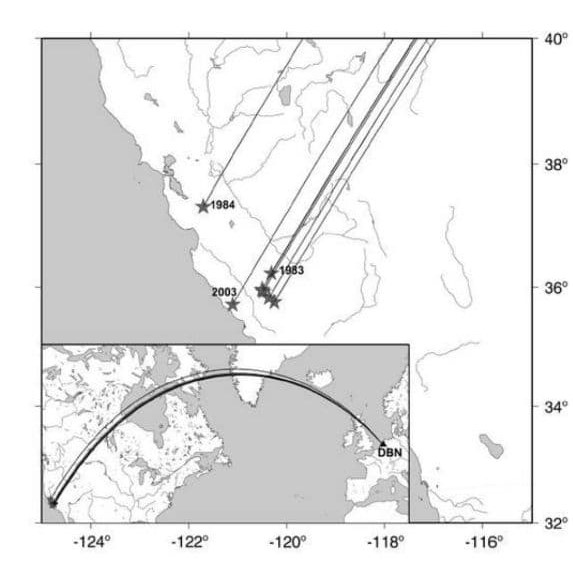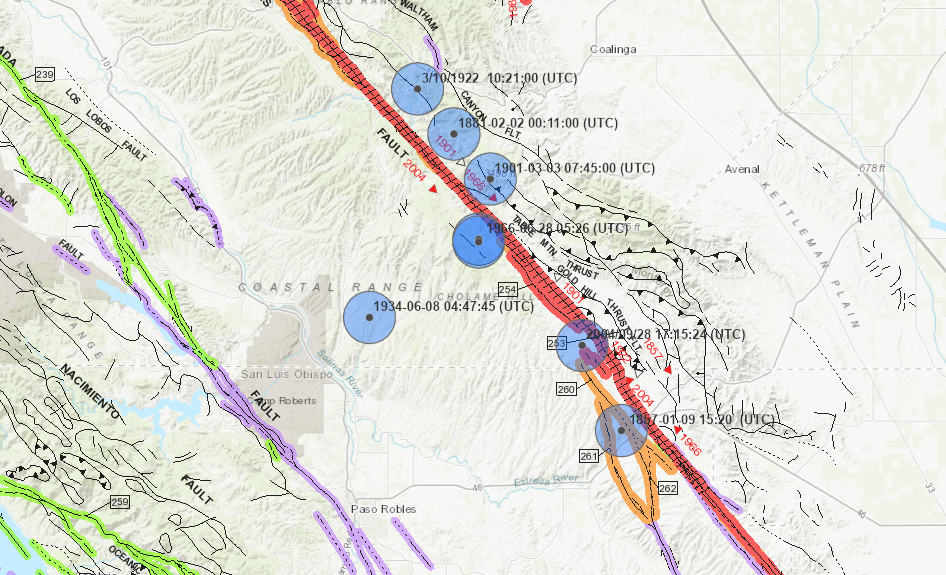Conclusion
Tectonic earthquakes happen mostly in boundaries of moving plates. In colliding process, while moving plates stick together by frictional
forces in contacting surfaces, the moving plates themselves deform. The deformed portions of crust set up stress in all points of crust
material. This process continues and, at some point, micro-cracks begin to form in mechanical weaker regions. More and more deformation
takes place and more energy is stored in compressed material. Subsequently, there will be a state where frictional forces are about be
equal to internal forces due to shape change. At this stage, a small perturbation can trigger the a rupture. Solid earth tides are always
present as a periodical perturbative agent. In this research it is shown that similar earthquakes around Parkfield originated in the same
fault system are tidally triggered. Breaking time intervals are between high to low tides. In these time intervals earthquakes were more
likely to happen. We conclude that solid earth tides are an important mechanism to initiate earthquakes. This fact can be used in
artificial intelligence earthquake forecast models for training purposes.
References
1) Bakun, W.H. and T.V. McEvilly, 1984. Recurrence Models and Parkfield, California, Earthquakes. J. Geophys.Res., 89, 3051-3058.
2) Bakun, W.H., B. Aagaard, B. Dost, W.L. Ellsworth, J.L. Hardebeck, R.A. Harris, C. Li, M.J.S. Johnston,J. Langbein, J.J. Lienkaemper,
A.J. Michael, J.R. Murray, R.M. Nadeau, P.A. Reasenberg, M.S. Reichle,E.A. Roeloffs, A. Shakal, R.W. Simpson and F. Waldhauser, 2005.
Implications for prediction and hazardassessment from the 2004 Parkfield earthquake. Nature, 437, 969-974. doi 10.1038/nature 04067
3) Dost, B. and H.W. Haak, 2002. A comprehensive description of the KNMI seismological instrumentation. KNMITechnical Report TR-245, 60pp.
4) Dost, B. and H.W. Haak, 2006.Comparing Waveforms by Digitization and Simulation of Waveforms for Four Parkfield Earthquakes Observed in
Station DBN, The Netherlands.Bulletin of the Seismological Society of America, 96, S50-S55. doi: 10.1785/0120050813
5) Langbein, J., R. Borcherdt, D. Dreger, J. Fletcher, J.L. Hardebeck, M. Hellweg, C. Ji, M. Johnston, J.R. Murray, R. Nadeau. M. J, Rymer
and J,A, Treiman. 2005. Preliminary report on the 28 September 2004, M 6.0 Parkfield, California Earthquake. Seismol. Res. Lett., 76, 10-26.
6) Michelini, A., B. De Seimoni, A. Amato and E. Boschi, 2005. Collecting, digitizing, and distributing historical seismological data.
EOS transactions American Geophysical Union, 86, 261-266.
7) https://earthquake.usgs.gov/learn/parkfield/1922.php
















